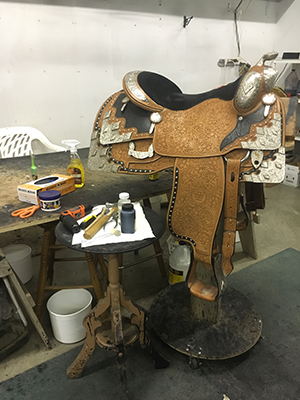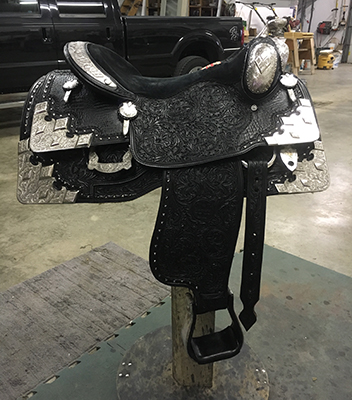 So, you saved and sacrificed and finally you managed to purchase that show partner you hope will take you to the top. But now there’s no money left for a shiny new saddle to ride in. What can you do? Maybe you can put it on a credit card. But there may be another option. What if you dyed your old show saddle to use now while you save up for a brand new one?
So, you saved and sacrificed and finally you managed to purchase that show partner you hope will take you to the top. But now there’s no money left for a shiny new saddle to ride in. What can you do? Maybe you can put it on a credit card. But there may be another option. What if you dyed your old show saddle to use now while you save up for a brand new one?
Kari Grefsrud of Pelican Rapids, Minnesota started dyeing saddles out of personal necessity.
Back in 2011, she and her sister, Lana, had been sharing an older show saddle and were in desperate need of a fresh look.
“We needed to decide if we should sell the saddle and buy a new one, dye the saddle we had at the time, or purchase new leather for it,” Kari explained.
The sisters began researching and determining the expenses involved for all their saddle options.
“If we were to buy a new saddle, it was going to cost us several thousand dollars,” Kari said. “We just couldn’t afford that. So, we went to the local Farm & Fleet, bought some dye, and gave it a shot. We literally read the instructions off the box dye, and that is exactly what we did.”
Before embarking on their mission, the sisters agreed that if their dyeing plan totally flopped, they would send the saddle out to have the leather replaced, which would set them back a few thousand dollars.
But the process worked and the Grefrud sisters realized they may be on to something. After that first saddle, they tried one for a friend and then another and soon word spread.
 Five years and some 300 saddles later, Kari has developed her craft into a business, all by word of mouth. Many trainers recommend her to their clients.
Five years and some 300 saddles later, Kari has developed her craft into a business, all by word of mouth. Many trainers recommend her to their clients.
“This job is self-serving for me because my hours are flexible and I can work from my home,” she said. “I enjoy outdoor activities, so I am able to work my lifestyle into my job. I am very blessed to be able to do that. I also like the fact that I can help people, like me, who can’t afford to spend what a new car costs on a saddle. It is nice that I can take something that they already have and make it new again. I feel good about giving new life to saddles.
Much has changed since Grefsrud changed the color of her first saddle using that Farm & Fleet box dye. She has tweaked and perfected the process for time and cost effectiveness over the years to achieve the best results possible. Kari still works out of her garage but today has a part-time employee helping with the actual dye process.
Although reluctant to reveal too many tricks to her trade, Kari did say that there is a process she uses with every saddle.
“There are four general steps with each saddle dyeing process,” she explained. “First, you prepare the saddle for dyeing by taking the pieces of the saddle apart. Second, you dye all of the saddle pieces. After that, a finishing coat is put on top of the dye, and last, but not least, the saddle must be put back together.”
Grefsrud said the entire process takes approximately two weeks to complete, not including shipping or wait time if she is still working on another saddle before a new customer’s saddle comes in.
 “Of course, occasionally there are some saddles that you can completely finish in a week, and on the opposite end, some saddles need to be stripped of a particular finish that may take many weeks,” Grefsrud explained.
“Of course, occasionally there are some saddles that you can completely finish in a week, and on the opposite end, some saddles need to be stripped of a particular finish that may take many weeks,” Grefsrud explained.
The hardest part, by far, is the preparation.
“The most difficult part is removing the silver and preparing the leather. If the leather isn’t prepped correctly, the dye will not hold,” Grefsrud explained. “The smooth finish has to be removed or the dye won’t penetrate into the leather. It will only sit on top of the finish.”
Getting the old finish off the leather is difficult and time consuming but worth the effort when try to achieve a quality new look in applying the new first coat.
“A good first coat will make the second coat much easier,” Grefsrud said.
In the 300 saddles Kari has “reimagined” over the past five years, there has only been one come in that she could not change.
“The finish on that saddle was really thick and hard. It would have taken hours and hours of work,” she explained. “I couldn’t have done it at that time in my career, but I could do it now.”
Grefsrud charges a flat $650 to dye a saddle.
“I have a middle price range,” she explained. “It isn’t too much for an amateur on a budget to upgrade to a new look if they can’t afford a new saddle. I am not so high that it detours people from considering the dyeing. I feel that I do some extra steps when dyeing saddles to make sure I send out a nice finished product. For the hours that I put in, I am very affordable.”
Dyeing a saddle can increase its longevity. It also gives exhibitors a brand, new look by using what they already have. But Grefsrud urges saddle owners to give it serious thought.
“This is permanent. If someone is even a little bit on the fence or uncertain about dyeing, I would tell them not to do it. If you are not 100 percent sure, but your trainer is, you still shouldn’t be forced to do it. You need to be comfortable with the change since it is permanent,” Grefsrud said. “There are times when people decide they want to do it but are still a little apprehensive, but it they generally end up really liking it.”
Colorado trainer Kelly McDowall has sent numerous saddles to Grefsrud to be dyed over the past few years.
“We have had five or six saddles dyed by Kari,” he said. “They all came back looking like a brand, new saddle. She takes them apart, cleans all the silver and dyes them very nicely. All the saddles are holding up very well.”
McDowall said the saddles they have sent to Grefsrud to be dyed have been slightly to well-used, light colored saddles.
“Some people can’t afford to buy a brand new saddle,” he explained, “so having a used saddle dyed black is just like getting a brand, new saddle.”
Grefsrud also said it’s important to think about the saddle dyeing in terms of how long you see yourself owning the saddle, matching it up with your current horse as well as with future horses. The saddle may match perfectly with the color of horse you have now, but you need to think about the future as well.
Depending on what color you choose for your saddle, it could mean a little more maintenance. Grefsrud said she thinks that dark saddles are relatively low maintenance, but some people don’t realize that they collect a lot of dust. She has had people come to her in a panic, complaining about the dark saddles being so dusty. Because of this, Grefsrud says there are three things that you will always find in her tack trunk at shows.
“Caring for the dark saddles doesn’t take a lot of time. I just make sure to bring a compressed air sprayer, liquid glycerin saddle soap, and a towel to every show for saddle cleaning purposes,” she said.
You may be wondering if dyed saddles ever need to be re-dyed, or how long does a dye job last?

Sarah Rosciti showing in the saddle she had dyed black.
Grefsrud said a good dye will last for many years, but there are a couple reasons why a saddle may need to be re-dyed sooner.
One reason a saddle may need to be re-dyed depends on the care the saddle has been given. Grefsrud says that the upkeep determines how long a dye will last, and everyone takes care of their equipment differently.
“Some people use their show saddles every single day, all year long for work and and show,” she said. “When that is the case, those are the types of saddles that may need to be re-dyed at some point.”
Sarah Rosciti, an American Quarter Horse Association (AQHA) competitor from North Scituate, Rhode Island, had her saddle dyed black four years ago and says it’s still in mint condition.
“We have had both a saddle and a bridle dyed by Kari. The saddle was ‘well used’ when we sent it to her,” Sarah said. “She sent it back looking brand new. It looked amazing! That was four years ago now, and the saddle is still in perfect condition. People always ask me who did it and I always refer them to Kari.”
Grefsrud said the style or brand of the saddle does not necessarily impact what the results will be like.
“I have dyed all different styles and brands of saddles,” she said. “I cannot say that lesser quality does not dye as well because they often don’t have the thick finish on them, so they end up dyeing nicely.”
The degree of difficulty with certain color choices varies. Although going from a lighter color to a darker color is what Grefsrud specializes in.
“What one person sees and perceives isn’t always what they are going to get,” she explained. “Each saddle leather has different qualities and grains. Brown is one of the more difficult colors to dye. Black is relatively easy to dye. When you dye a black or dark saddle, you hope that the color penetrates so deep into the leather that it will never come off.”
One process Grefsrud has not yet mastered is dyeing a dark colored saddle back to a light color.
“I have experimented with leather swatches, but haven’t had much success,” she said. “I don’t foresee this process being too successful, but I haven’t given up yet. I still have a few things I want to try.”


You must be logged in to post a comment Login